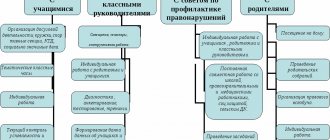Deviant behavior is characterized by a change in a person’s behavior that deviates from generally accepted norms and socially approved standards. The problem of deviant behavior has been facing humanity for a long time. Such manners are not approved by social society and norms. A deviant is a person who has distinctive characteristics in personal qualities, behavior, and actions. The study of deviants is carried out by social sciences, medicine, psychological and psychiatric fields.
Main forms of deviant behavior
Types of deviant behavior include the following forms of manifestation:
- Asocial appearance. In this case, the behavior demonstrates the deviant’s propensity to engage in actions that may threaten relationships between people. As a result, a person destroys the established order of interpersonal interaction. This may be accompanied by symptoms such as aggression, gambling addiction, vagrancy, sexual inclinations, etc.
- Antisocial. It is characterized by a complete violation of legal norms, which can lead to a threat to social order. In most cases, deviance is manifested by committing actions that are prohibited by law.
- Self-destructive type. Prevents the individual from normal existence in society. In this case, the deviant expresses his thoughts through a tendency towards suicidal actions, drug use, the choice of life-threatening activities and the manifestation of fanatical behavior patterns.
The form of deviant behavior can be expressed in negative factors, which is accompanied by the development of various types of addictions. However, deviant behavior is not always a negative reaction. Its positive form is expressed by a pathological tendency towards social creativity and altruism. Or a socially neutral form is identified, characterized by begging or vagrancy.
Signs of deviant behavior
There are clear signs that an individual’s actions are deviant behavior, namely
:
- Inconsistency with generally accepted social norms;
- Violation of these norms;
- Negative assessment of others, imposition of sanctions;
- Causing harm to yourself and others;
- Persistence – the antisocial act is repeated many times;
- Social maladjustment;
- The general orientation of the personality is destructive.
The last feature, however, is controversial. After all, the concept of deviant behavior also includes cases such as talent, genius, heroism and self-sacrifice. Such actions and manifestations also violate some established rules, but ultimately their goal is the creation, sometimes even the salvation of society.
Causes of deviant behavior
The causes of deviant behavior are formed under the influence of numerous factors. Nevertheless, such behavior is considered intermediate between a pathological state and norms.
The causes of deviation are formed based on the following factors:
- Social factors.
- Peculiarities of upbringing, the presence of role anomalies in the family.
- Psychophysiological factors, which include hereditary pathologies, features of the perinatal period, age-related crises, and so on.
- Personal factors.
- Nervous system disorders accompanied by increased anxiety, bad mood, constant internal conflict, and depression.
Often, deviant signs begin to appear against the background of cognitive impairment, and therefore they are among the reasons due to which a mental disorder develops.
What is deviant behavior?
Let's start with a short historical excursion. The term “deviant behavior” comes from the word deviation, which in most European languages means “deviation”. The first concept of “deviance” or “deviance” was introduced into scientific circulation by the French philosopher and sociologist David Emile Durkheim (1858-1917).
The focus of his scientific attention was the topic of social integration in a rapidly changing society, which was fully observed in Europe in the second half of the 19th century. His work “Suicide: a sociological study”, first published in 1897, translated into many languages of the world and went through many reprints, became a landmark work [E. Durkheim, 1994].
This book examines various aspects of suicidal behavior as deviating from generally accepted norms and basic instincts. In addition, Emile Durkheim used the definition of “anomie” in relation to a society in a state of disorganization and disorientation, when the very concept of norm becomes blurred. It is quite logical that in this case it is much more difficult to determine what is a deviation from the norm than in conditions of stability.
One way or another, today deviant refers to human behavior that deviates from generally accepted and most widespread social norms in a given society at a given point in time. This refers to both expected social behavior adapted to the requirements of society and deviant behavior that deviates from the standard and social expectations.
We have already clarified that different communities may have different concepts of the norm at the beginning of the article. Relatively speaking, the standards of behavior among members of the academic council of the university and the society of anonymous alcoholics will differ markedly.
I think everyone can see for themselves how social norms change over time. Suffice it to say that in the United States, which considers itself a model of democracy, there was an official ban on interracial marriages until 1967, and violation of the ban was punishable by imprisonment. Interestingly, in the state of Alabama this ban was lifted only in 2000. You can read about the ups and downs of the struggle of Americans for the right to love each other regardless of skin color [B. Cabell, 1999].
We gave this example solely to illustrate how the concept of a social norm can change in just about 50 years. What was once a criminal offense is now a taken-for-granted right of all and everyone, which does not even occur to anyone to discuss or question. And if it comes, then doubts of this kind can be interpreted as a violation of the law and discrimination on the basis of race.
Another thing remains unchanged: violation of established norms leads to sanctions from society, ranging from moral condemnation to imprisonment. In other words, it does not matter what is meant by the norm. The important thing is that a violation can result in imprisonment. Until 1967, people in the United States were jailed for interracial marriage, but now they are jailed for refusing to register same-sex marriages [BBC, 2015]. What they would do in the United States with a judge who would decide to refuse to register an interracial marriage, we cannot even imagine.
The traditionally negative connotation of the very concept of “deviant human behavior” remains unchanged, although “deviant” only means “deviant.” And deviations, as we have already found out, can be in any direction. For example, parents who abuse alcohol may grow up to have a purposeful son who leads a healthy lifestyle and wants to get an education and a profession. But in this case, he will face misunderstanding and even condemnation from his relatives, who are perplexed about what kind of nonsense this higher education is.
Nevertheless, it is necessary to distinguish between positive and negative deviation:
- Negative deviation includes any crimes and offenses, alcoholism, drug addiction, prostitution, harassment, unethical behavior, manifestations of mental disorders in the form of suicidal tendencies, self-harm and others.
- Positive deviation includes self-sacrifice, heroism, altruism, workaholism, a heightened sense of pity, outstanding talents and abilities, giftedness, etc.
Forms of behavior classified as positive deviation are certainly a deviation from the norm, because not all people have any obvious talents, and few are able to risk their lives to save another person.
The distinction between positive and negative deviation has more of a cognitive rather than an applied aspect. The subject of scientific and practical research in the vast majority of cases is precisely negative deviation as representing the greatest potential danger. Based on all of the above, we can identify the main signs of deviant behavior in the context of negative deviation.
Signs of negative deviant behavior:
- Does not correspond to the norms accepted or officially established at a given time in a particular society.
- It has a stable, repeatable character.
- Causes a negative response from others or so-called “social sanctions”.
- May be subject to forced correction by the state (imprisonment, compulsory treatment, other forms of isolation).
- Causes damage to the person committing deviant behavior and/or the people around him.
- Accompanied by social maladjustment.
- May have medical, social or psychological causes.
And finally, it is worth outlining the age boundaries of the phenomenon. At what age can behavior that does not correspond to social norms be considered deviant? It is clear that the baby cannot behave in accordance with the norms accepted in society. And in principle, he cannot be aware of himself, his behavior and everything that is happening around him.
When considering the deviant behavior of children, experts usually agree that this term should be applied to children starting from older preschool age, because earlier, for objective reasons, they cannot fully understand the consequences of their even the simplest everyday actions. Up to 5 years of age, deviations in children’s behavior can be considered the norm [Yu. Zhokhova, 2017].
Therefore, when talking about deviations, we will mean children aged 5 years and older, teenagers and adults. As you already understand, deviant behavior in society can have a variety of reasons and a variety of manifestations. Let's talk about this in more detail.
Prevention of deviant behavior
Timely started preventive measures significantly delay the onset of the disease, or the disorder manifests itself to a minor extent, which allows you to gain control over negative emotions. The fight against deviant behavior, as well as its manifestations in various types of addictions, is based on the following recommendations.
Development of negative reactions in the patient to addiction, including gaming, narcotic, etc. In this case, the following methods are used:
- Indication of problems and existing issues with the involvement of the media. In this way, it is possible to notify and convey the necessary calls both to a specific patient and to the entire society.
- Conducting conversations that demonstrate the possibilities of combating addictions. The context of the phrases is not an indication of the need to get rid of bad habits, but a notification of specific actions. We should talk about specific experiences of getting rid of addiction, ways to stop taking drugs, and so on.
- Promotion of a healthy lifestyle, which can be transmitted both to a specific patient and to a huge audience at once.
- Attending special classes that promote cessation of drug use, or holding mass classes in the form of lectures that talk about this.
Development of comprehensive measures aimed at preventing addiction with the involvement of specialists in this field. Abuse of illegal substances threatens not only the individual, but also society. Therefore, special services should also be interested in issues of prevention. In this way, rehabilitation programs are created that include not only preventive measures, but also therapeutic ones.
Deviant behavior threatens humanity not only in the form of addiction, but also in aggressive actions, therefore, if a person has tendencies, it is necessary to schedule an examination with the involvement of a psychiatrist. If there are already existing signs of deviant behavior that are clearly formed in the patient’s mind, it is necessary to conduct a psychiatric study and, if necessary, prescribe treatment with possible isolation of the patient.
Types of deviant behavior
Psychology, sociology and medicine have their own approaches to defining deviant behavior and classify its types in different ways. Different scientific directions even define actions and actions differently - one school considers some action “normal”, while another considers it deviant.
One of the existing classifications of deviant behavior was proposed by Ts.P. Korolenko and T.A. Donskikh - domestic psychiatrists.
- Non-standard behavior
- in this case, the individual violates some rules, but in general his activities are positive and useful for society. - Destructive behavior
– has a destructive orientation. In this case, externally destructive and internally destructive actions are distinguished. In the first case, a person either uses certain means to escape reality and get the desired emotions (alcoholism, drug addiction, gambling, etc.), or directly violates laws and causes harm to others.
In the second case, a person’s actions are aimed at direct self-destruction - suicide, fanaticism, conformism, narcissism, etc.
Human behavior itself is a reaction to social norms. There can only be a few such reactions, and their description was given at one time by Robert King Merton, one of the greatest sociologists of the twentieth century.
Each society forms both the goals of its existence and the means of achieving them, and each individual responds to this through one of the possible reactions
:
- Submission - complete submission to both goals and means of achieving them;
- Innovation - the individual submits to the goals of society, but uses other means to achieve them;
- Ritualism - the goal is rejected as unattainable, but a “mechanical” adherence to traditions remains;
- Retreatism is withdrawal from society due to disagreement with its goals and means;
- Rebellion is an attempt to bring a new order to society, to change both goals and means.
Three of these types of behavior are outright deviant. But ritual behavior in most cases is not perceived as deviant: society, as a rule, pays attention only to the external side of the behavior of individual people. It is believed that almost all members of society practice ritual behavior without thinking about the purposes of existence or even outright denying them.
§ 14. Social norms and deviant behavior
Question 1. Is it true that the activities of each person are controlled by society? Is it good or bad? Are there rules of conduct for everyone? What kind of person can become a criminal? What are the dangers of alcohol and drugs?
Yes, this is good because society helps a person not to stray from the right path, not to make mistakes.
Social norms are general rules and patterns of behavior that have developed in society as a result of long-term practical activities of people, during which optimal standards and models of correct behavior were developed.
Social norms determine what a person should do, how he should do it, and finally, what he should be like.
The personality of a criminal differs from the personality of a law-abiding person in that it is a social danger; it is characterized by criminal needs and motivation, emotional-volitional deformations and negative social interests.
Alcohol does not solve problems, but on the contrary makes them even worse. In a state of intoxication, a person commits inappropriate actions, the normal functioning of many organs (including the brain) is disrupted, which leads to its gradual degradation, and relationships with other people are also destroyed. And if you don't stop in time, it ultimately leads to death.
Questions and tasks for the document
Question 1. Give your own examples of universal, racial, class, group norms.
Universal ones: raising children, helping the sick and the elderly, and biblical ones (thou shalt not kill, thou shalt not steal, thou shalt not commit adultery).
Racial: let’s say the Caucasian race has general democratic values (equality before the law, elections of the head of state, freedom and value of the individual), while the Mongoloid race usually has a dictatorship of the head of the state or the ruling party, the value is not personal, but collective benefit.
Class: Courchevel for the oligarchs, Turkey and Egypt for the middle class and a village for the poor.
Group: for students - study and, accordingly, everything connected with it, for athletes - training, for the military - exercises or combat operations.
Question 2. To what level of community can the norms be attributed: “don’t steal”, “before the New Year we go to the bathhouse together”, “separate education for blacks and whites”, “solidarity of workers of all countries”?
1. Universal.
2. Intragroup.
3. International
4. Group.
Question 3. What does a higher or lower level of norms mean? Why do the authors place natural human rights at the highest level?
A higher level of social norms are those norms that play the greatest role in society and the violation of which leads to significant negative consequences for the individual and society as a whole.
Lower level of social norms - violation of which does not cause much harm to society and therefore informal social control is quite sufficient.
Question 4. Why is the most decisive government action necessary in the event of a violation of higher-level norms?
Because if high-level norms are violated, the consequences can be much more serious.
Question 5. How does social control manifest itself in the event of a violation of a lower level of social norms? Why?
It is expressed in informal pressure from society on the offender. Public censure, ostracism, etc. Because the norms of the lower level, although not written down as law, the implementation of these norms as a whole is socially justified in the environment.
Question 6. How can we explain that a more democratic society involves a shift in emphasis from external social control to internal self-control?
Self-control is the subject’s awareness and assessment of his own actions. Self-control is closely intertwined with the concepts of conscience and morality. Internal self-control is characteristic of societies with a high moral component, i.e. with conscience. A democratic society advocates weakening external control, relying on internal self-control, which results in an increase in deviance (deviation from generally accepted norms) of the social environment.
SELF-TEST QUESTIONS
Question 1: Give examples of each type of social norm.
Main types of social norms:
1. Rules of law are generally binding, formally defined rules of behavior that are established or sanctioned, and are also protected by the state. (Laws of the Criminal Code, AK).
2. Norms of morality (morality) - rules of behavior that have developed in society, express people’s ideas about good and evil, justice and injustice, duty, honor, dignity. The effect of these norms is ensured by internal conviction, public opinion, and measures of social influence. (We must respect elders and help the disabled).
3. Norms of customs are rules of behavior that, having developed in society as a result of their repeated repetition, are followed by force of habit.
4. Norms of public organizations (corporate norms) are rules of conduct that are independently established by public organizations, enshrined in their charters (regulations, etc.), operate within their limits and are protected from violations by them through certain measures of social influence.
Question 2. What is social control?
Social norms constitute one of the elements of the mechanism for regulating relations between the individual and society, which is called social control. The purposeful influence of this system on people's behavior in order to strengthen order and stability is ensured by social control.
Any activity includes a variety of actions, and each person performs them many times, entering into active interaction with the social environment (with society, social communities, public institutions and organizations, the state, other individuals). All these actions, individual actions, and human behavior are under the control of the people, groups, and society around him.
As long as these actions do not violate public order or existing social norms, this control is invisible, as if it does not exist. However, it is worth breaking the rules, deviating from the patterns of behavior accepted in society, and social control manifests itself.
People who reacted to the violation of social norms reflected the attitudes of public consciousness (or public opinion), which supports the order protected by norms. That is why their reaction was to condemn these actions. Expressing dissatisfaction, reprimanding, imposing a fine, punishment imposed by a court - all these are sanctions; Along with social norms, they are an essential element of the mechanism of social control.
Sanctions mean either approval and encouragement or disapproval and punishment aimed at maintaining social norms. In other words, sanctions can be either positive, which are aimed at encouraging, or negative, aimed at stopping undesirable behavior.
Society (large and small groups, the state) evaluates the individual, but the individual also evaluates society, the state, and himself. Perceiving assessments addressed to him from surrounding people, groups, government institutions, a person accepts them not mechanically, but selectively, rethinks them through his own experience, habits, and previously acquired social norms. And a person’s attitude to other people’s assessments turns out to be purely individual; it can be positive and sharply negative.
Thus, along with control from society, a group, the state, and other people, internal control, or self-control, which is based on norms, customs, and role expectations learned by the individual, is of utmost importance.
Question 3. What is the meaning of self-control?
In the process of self-control, conscience plays an important role, i.e., the feeling and knowledge of what is good and what is bad, what is fair and what is unfair, the subjective consciousness of compliance or non-compliance of one’s own behavior with moral standards. In a person who, in a state of excitement, by mistake or succumbing to temptation, commits a bad act, conscience causes a feeling of guilt, moral worries, a desire to correct the mistake or atone for the guilt.
The ability to exercise self-control is the most valuable quality of a person who independently regulates his behavior in accordance with generally accepted norms. Self-control is one of the most important conditions for a person’s self-realization and his successful interaction with other people.
Question 4. What are the causes of deviant behavior?
Researchers have different points of view on this issue.
At the end of the 19th century. a biological explanation for the deviations was put forward: the presence in some people of an innate predisposition to violations of social norms, which is associated with the physical characteristics of the individual, criminal temperament, etc.
Other scientists have sought psychological explanations for the abnormalities. They came to the conclusion that an important role is played by the value-normative ideas of the individual: understanding of the world around him, attitude to social norms, and most importantly, the general orientation of the interests of the individual. The researchers came to the conclusion that behavior that violates established norms is based on a different system of values and rules than the one enshrined in law.
For example, cruelty can be the result of a cold, indifferent attitude towards a child on the part of parents, and often the cruelty of adults. Studies have shown that low self-esteem in adolescence is compensated for in the future by deviant behavior, with the help of which it is possible to attract attention and gain approval from those who will evaluate violation of norms as a sign of a strong personality.
The sociological explanation of deviant behavior, the causes of which the famous sociologist E. Durkheim saw as depending on the crisis phenomena occurring in society, has received wide recognition. During crises, radical social changes, in conditions of disorganization of social life (unexpected economic downturns and upswings, decline in business activity, inflation), a person’s life experience ceases to correspond to the ideals embodied in social norms. Social norms are destroyed, people become disorientated, and this contributes to the emergence of deviant behavior.
Some scientists have associated deviant behavior with a conflict between the dominant culture and the culture of a group (subculture) that denies generally accepted norms. In this case, criminal behavior, for example, may be the result of an individual’s primary communication with carriers of criminal norms. The criminal environment creates its own subculture, its own norms, opposing the norms recognized in society. The frequency of contacts with representatives of the criminal community influences the assimilation by a person (especially young people) of the norms of antisocial behavior.
Question 5. What is the social danger of crime?
Organized crime poses the greatest danger to individuals, society, and the state. In the broadest sense of the word, it refers to any group of persons organized on a permanent basis to obtain funds through illegal means.
The danger to the individual lies in the suppression of his rights and freedoms through acts of violence and other means. This is manifested in the destruction of small entrepreneurs who refuse to pay money to obtain protection from criminals (racketeering); forcing women and teenagers into prostitution; spreading influence and control, for example, over trade unions; rising costs of goods and services; the possibility of complete suppression of the constitutional rights and freedoms of citizens through physical and moral terror.
The danger to society lies in the interception of the rights to own and dispose of the material assets of the entire society by organized criminal communities and corrupt groups of officials (especially in the areas of trade, production and distribution of strategic raw materials, precious metals, production and circulation of weapons); the ability to manipulate significant capital, penetrate into areas of legitimate business and ruin their competitors through price controls; propagation of the ideology of the criminal world, its romanticization, cultivation of mafia and corrupt relations, violence, cruelty, aggressiveness, which creates conditions for “social contamination” by criminal customs and traditions.
The danger of organized crime for the state is manifested in the creation at the regional level of parallel illegal power structures and illegal armed groups; preparation, financing and organization of direct anti-constitutional actions in the form of inciting national hatred, organizing mass riots, conspiracies to seize power; promoting crimes such as banditry and smuggling; penetration of political parties and the state apparatus by corruption; a desire to weaken federal power in order to facilitate the control of organized crime over entire regions.
Question 6. What are the consequences of drug addiction for the individual, family, and society?
The consequences of drug addiction for the family are catastrophic, as well as for the individual himself. The personality itself becomes completely asocial over time. Social attitudes are completely erased - social statuses such as professional, father, son, comrade, etc. The existence of the subject is reduced only to finding doses and use; as a rule, with longer use in a person’s life, there are no longer any other needs. The family constantly lives in stress, which in itself is called codependency, that is, the whole life of the family over time becomes focused only on the life of the drug addict. As a rule, the family begins to experience serious financial difficulties, and a lot of serious illnesses are recorded among codependent relatives of drug users.
TASKS
Question 1. How do you feel about the statement of the English historian G. T. Buckle (1821-1862): “Society prepares a crime, the criminal commits it”? Explain it with some example taken from newspapers.
I understand that any crime is determined by social factors that shaped the personality of the criminal, or created the situation that led to its commission. And the criminal, as it were, plays the role of a “performer” who resolves this situation in a negative way.
Question 2. Do you agree with the statement of the French playwright J. Racine (1639-1699): “Major crimes are always preceded by small ones. Has anyone ever seen timid innocence suddenly turn into rampant debauchery? Give reasons for your answer.
I agree, the reason for this is cause and effect. Many famous criminals started with petty thefts and could not stop.
Question 3. A discussion arose on the issue of fighting crime. One side argued: “Penalties need to be toughened. Look at Singapore. If you were caught with drugs - capital punishment, with an illegal weapon, even if you did not use it - the same. In some Muslim countries, the law requires the hand to be cut off for theft. And no one has been stealing there for a long time.” Another objected: “The cruelty of punishments will make crime more violent. The main thing is the inevitability of punishment. If everyone knows that any crime will be solved, crime will decrease dramatically.” What do you think about this issue? Give reasons for your answer.
Any court is not immune from errors, while it must make decisions. With capital punishment, an innocent person may suffer, and this cannot be corrected. The inevitability of punishment makes the chance of committing a crime minimal, because the criminal realizes that he will be found and punished.
Examples of deviant behavior
An example of positive deviance would be the rescue of a child from a fire by a stranger. Entering a burning house without a special suit or equipment is a brave and courageous act, but it is different from the behavior of most people. Such actions indicate increased social responsibility and are considered deviant.
The immoral type of deviation occurs among persons without a fixed place of residence. They look inappropriate, drink alcohol and drugs, can be rude to people and beg. This behavior does not harm others, but causes rejection and hostility.
A striking example of addictive deviance can be people who are passionate about computer games. Gaming is an interesting and exciting hobby, but for deviants it replaces real life. A person begins to spend all his free time on the computer, spends all his savings on new games, and stops contacting the outside world.
Deviation from social norms is treated using psychotherapeutic methods, yoga and breathing exercises. If the cause of the deviation lies in biological factors, then it is medicated with the help of antidepressants, sedatives and hypnotics, B vitamins. Deviant behavior is easier to prevent by building a warm relationship with the child and conducting conversations.










